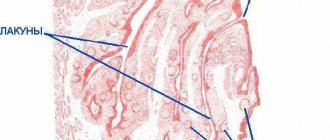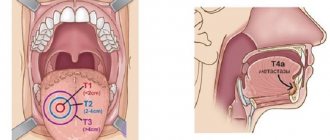Tongue cancer is a fairly rare disease, but despite this, more and more cases of this pathology are registered every year. The most important thing is to pay attention to the early signs when a tumor appears; besides, it is quite difficult to miss. It should be noted that most often males suffer from tongue cancer, while women are least affected by this disease. What are the symptoms of tongue cancer?
Causes of tongue cancer
The symptoms of tongue cancer cannot be confused with anything!
Tongue cancer, like any other form of malignant tumor, appears for a reason. Its appearance is preceded by many factors that provoke cell mutation. The main causes of tongue cancer include:
- Excessive smoking. But in some cases, even smokers with little experience may develop a tumor. This is due to the individual characteristics of the body and the structure of the mucous membrane
- Chewing nicotine gum, which is used by people if they want to get rid of a bad habit.
- Chewing tobacco, which irritates and damages the mucous membranes
- Excessive consumption of alcoholic beverages
- Heredity. Many people know that if someone in their family had one or another cancer disease, then their descendants are at risk
- Serious diseases that can provoke a decrease in the body’s defenses, that is, immunity
- Papilloma virus. Scientists attribute an increase in the number of cases of patients with tongue cancer to this reason. This is because people are engaging in oral sex more often. And, as you know, papilloma is transmitted both sexually and oral
- Inflammation of the gums that remains untreated for a long period of time
- Poor dental condition
Despite the fact that almost everyone knows about the main causes of tongue cancer, few people pay attention to them. And therefore, every year the number of people with this disease, which is not so easy to treat, is growing.
Precancerous conditions
We should also talk about those diseases that are classified as precancerous conditions. It is they who need to pay more attention and treatment, since any factor can provoke the degeneration of simple cells into cancerous ones. Such diseases include:
- Leukoplakia. This is keratinization of the mucous membrane in the mouth, most often a red stripe appears on the lips. The main reason for the appearance of this disease is a decrease in the stability of the mucous membrane in the gastrointestinal tract, which leads to the penetration of harmful microbes and viruses into it, which can provoke cell mutation
- Papilloma. This is a benign formation, which consists of papillary growths of connective tissue. In themselves, such formations are painless, but they pose a great danger associated with the possibility of the tumor degenerating from benign to malignant
- Ulcer. It often happens that a person damages the oral mucosa. This can occur as a result of biting the cheek, tongue, cut, or thermal burn. In the event that no antibacterial treatment is carried out, the likelihood of ulcers on the mucous membrane increases, and as a result, in the future, the formation of cancer cells
- Glossitis. This is a very rare disease, but still encountered in medical practice, which is characterized by pain in the tongue, as well as increased salivation.
- Bowen's disease. This disease is characterized by the appearance of a small spot on the tongue, which has a rough surface. Over time, erosion may appear on it
If a patient is diagnosed with one of the above diseases, then close attention is paid to its course, as well as treatment. Due to the fact that some of these diseases cannot be completely cured, a person is recommended to visit a specialist every six months or year for a full examination and examination in order to control the situation.
Causes, risk factors
Possible causes of tongue cancer look like this:
- The influence of carcinogens in tobacco and other smoking mixtures.
- Constant exposure to alcohol on the tongue. Interesting fact: recent studies show that alcohol can enhance the effects of carcinogens found in tobacco.
- Contact with harmful substances: salts of heavy metals, asbestos, petroleum products - for example, when working in hazardous industries.
- Regular mechanical injuries to the tongue - biting, exposure to dentures, rubbing the tongue with a splintered tooth or poorly chosen filling, etc.
- The effect on the body of HPV - specifically strains that have a high oncogenic risk. People with HIV and other viruses are also at risk.
- Precancerous conditions of the tongue, which can later develop into cancer. These are chronic ulcers, papillomas, lichen planus, Bowen's disease, etc.
Obviously, not all reasons can cause tongue cancer (and not always) - we are only talking about a significant increase in risks.
Symptoms of tongue cancer
Papillomas can cause cancer
Tongue cancer is one of the diseases whose symptoms are so vivid that they force a person to independently seek medical help from a specialist. The main symptoms of tongue cancer include:
- The appearance of plaque or spots on the tongue itself. The spots and amount of plaque may vary for each person, as it depends on what stage of cancer, where in the tongue it is located, etc.
- The appearance of ulcers on the tongue
- The appearance of a small lump on the surface of the tongue, which indicates that the person has the first stage of tongue cancer
- Painful sensations that primarily appear at the site of the tumor. But sometimes the pain can radiate to the jaw, throat, ear or nose. Very often, pain intensifies when a person eats food, especially solid food.
- Bad breath, which occurs due to the presence of cancer cells in the mouth
- Inflammation of nearby lymph nodes. One of the most obvious signs of any cancer is enlarged lymph nodes. This pathology is characterized by enlargement of the cervical and submandibular lymph nodes. Separately, it is worth saying that not one node will be enlarged, but the entire group at once, which should alert any person
- Increased production of saliva, which has nothing to do with food intake or hunger
Depending on where the tumor is located on the tongue, certain symptoms will be more pronounced, or, conversely, more blurred.
It is customary to distinguish several options for the location of the tumor:
- At the root of the tongue
- On the side surface. Most cases occur in this location of the tumor
- On the bottom surface
- On the top surface
The symptoms of tongue cancer cannot be confused with almost anything. In addition, discomfort in this area is noticed almost immediately, since the resulting tumor interferes with normal eating, and sometimes can even interfere with conversation.
Growths on the tongue: what are they and can they be removed?
Classification of pimples
There are many different types of spots on the tongue. They are classified according to four characteristics: color, location, size and pain.
- Natural, red and pink. Colorless and painless, these are warts or condoms.
- If red or blood spots appear on the tongue, as in the photo, they can be caused by burns, herpes, or allergic reactions.
- Red pimples that turn black are associated with mechanical damage or injury. The black color is caused by micro-blood leakage.
Location
- On the tip of the tongue. This area is often susceptible to trauma and various types of damage that can cause inflammation. First, a small lump appears on the tip of the tongue, then a painful red or black pimple.
- From the outside. In most cases, localized acne due to stomatitis and benign tumors occurred in this area.
- On the larynx. Red pimples on the tongue closer to the throat are often benign formations: condylomas, warts.
- Under the tongue. Cones and mounds at this point (near the frenulum) indicate inflammatory processes in both adults and children: tonsillitis, angina, pharyngitis.
Presence of pain
- Sick feelings. Pimples caused by injuries, burns, inflammatory and infectious lesions of the oral cavity and larynx. Pain when touching tuberculosis, pain when talking, swallowing.
Without pain. In most cases, painlessness is typical for warts and condoms. Benign neoplasms often affect the root of the tongue. The photo shows what he looks like with acne.
Causes of pimples on the tongue
The main causes of the rash:
Language is a mirror of health. Defining health through language
- Traumatic injuries, burns. Often the tip or side of the tongue is damaged by cutlery, excessively hot food or your own teeth.
- Weakened immune system. If spots appear on the tongue closer to the throat, base of the tongue, or near the frenulum, this may be a sign of a weakened immune system. A large number of pimples and nodules are localized here: condoms and warts, mounds of candidiasis.
- Development of benign and malignant tumors.
- Wrong diet, bad habits. Excessive consumption of spicy, spicy, rough foods in violation of nutritional rules has an irritating and traumatic effect on the mucous membranes, provoking the appearance of acne. Excessive smoking and alcohol abuse also cause mucosal diseases in adults.
- Causes a knot at the end, the root of the tongue may be allergic. Allergic disease manifests itself not only on the skin, but also on the mucous membranes.
Large mounds near the throat, preventing the swallowing of food, can lead to blockage of breathing.
Difference between papilloma and polyp
Papillomas and polyps have a similar nature, but fundamentally different pathologies:
- A polyp is a benign tumor without critical health consequences. With timely treatment, it has little chance of developing into a malignant tumor and cancer. The reason for the growth of polyps is unknown to modern medicine.
- Papilloma is necessarily the result of a viral infection through contact of any kind (except through the air) with a cross-infected person.
The big difference in defining a neoplasm is its location. The polyp grows on the mucous membranes and is difficult to detect on its own. Papilloma forms on the external tissue and is easy to recognize.
Red bumps on the tongue closer to the throat - what are they?
In most cases, dents at the base of the tongue, pimples on the side, growths on the tip of the tongue are manifestations of the following diseases:
- Diseases of an inflammatory nature of the mucous membrane (glossitis) are accompanied by the formation of painful red rashes on the mucous membrane, in severe form - pustules, phlegmon.
- Metabolic disorders, vitamin deficiency. Such conditions are characterized by redness and an increase in the number of taste buds, often inflamed, becoming red and white in color.
- Herpes, characterized by painful red pimples and blisters.
If red bumps or nodules are present at the base of the tongue, this may be a symptom of pyogenic granuloma. The formations consist of blood vessels and are located in the affected area. The pathology is caused by injuries and damage to the mucous membrane. A person feels a sharp pain when he touches the mass.
- Digestion (malabsorption). Pimples at the root, all over the tongue, are one of the symptoms of this pathology.
- Candidiasis (thrush). A disease that often affects newborns. The baby's tongue is covered in red dumplings and has wavy shaped plaques. The child behaves restlessly, cries, has difficulty swallowing, such symptoms are caused by itching red and white pimples, dry mouth.
- HPV is the human papillomavirus. Formations are localized in every part of the tongue: at the tip, at the root, at the side. Lumps on the tongue, located closer to the larynx, are especially unpleasant because they interfere with swallowing and cause a foreign body sensation in the mouth.
- Allergic diseases. It doesn't hurt to get up, but it makes it difficult to swallow and speak.
- Diseases typical for children: Chickenpox, measles.
Treatment of pimples on the tongue
When examining the tip of the mucous membrane, the side, and the root of the tongue, the doctor examines the red dumplings and sprouts. Based on laboratory tests, examination and medical history, the specialist makes a diagnosis, finds out why the disease occurred and determines the therapeutic direction. The classic method of treatment is drug treatment:
- antibiotics are used to kill bacteriological pathogens . Drugs are effective for local action: bioparox, fusafungin. As well as medications for systemic treatment: amoxicillin, cefadroxil.
- To prevent rashes, prescribe anti-inflammatory drugs: Stomatimidine, Ingalipt, Lugol.
- Antiseptics accelerate wound healing: chlorhexidine (dressing, irrigation).
- Dysbacteriosis, which can cause a rash in the mucous membrane, is treated with probiotics: Bifidumbacterin, Acipol, Linex, Bifiform.
- If your child has pimples on the tongue, often caused by fungal infections, Thrush Treatment Anti-drug medications . It is worth rubbing your tongue, cheeks and lips with a broad spectrum Candida solution daily. After 1-2 days, the forms of plaque decreased, and after a week the signs of the disease completely disappeared.
- Allergic reactions are eliminated with antihistamines: Fenistil, Cetrin, Erius.
Treatment of growths
Oral ulcers are treated with these methods:
| Type of therapy | The essence of the procedure |
| Dental laser | Makes it possible to remove excrement in the most difficult places (at the base of the root of the tongue, at the entrance to the esophagus). Thanks to this method, you can get rid of the pathology painlessly and immediately |
| Radiosurgical removal | Recommended for the treatment of papillomas. The method is also safe for the child, as it helps to detect pathological tumors, which contributes to their rapid disappearance. |
| Surgical removal | It becomes obvious when warts on the mucous membrane grow to gigantic sizes and alternative treatments cannot cope with the problem. Removal of the tumor is performed under local anesthesia and a suture is placed at the site of removal. |
| Electrocoagulation | The properties of high-frequency current are used for local impact on the tumor, cutting off and sealing the donor site. This helps to avoid relapses and inflammatory complications. |
Pimples appeared on the tongue: treatment at home
Once the doctor has determined the type of rash, he can prescribe comprehensive treatment for the disease (drug and herbal therapy) or non-medical treatment at home. Pimples at the root, tip, near the frenulum of the tongue can be removed using folk remedies.
Herbal medicine
Pimples on the tip and base of the tongue Herbal decoctions and tinctures are removed qualitatively. The most effective rinsing is chamomile, St. John's wort, calendula. Herbal teas are especially effective for rash inflammation.
Method for preparing the broth: put a teaspoon of herbs in a glass of boiling water, let it sit for about 15 minutes, let cool. Rinse your mouth 2-4 times a day.
The infusion and broth can be taken orally, this helps alleviate the symptoms of the disease, relieve inflammation, and stabilize metabolic processes.
Compresses and lotions
If the formation is inflamed, you can relieve pain and inflammation by applying a cotton swab moistened with a herbal decoction of chamomile and calendula to the affected surface.
Anesthesia of the surface of the tongue can be achieved by using prophylactic toothpaste, which is applied for 2 minutes. Toothpaste relieves pain, has a soothing, anti-swelling and anti-inflammatory effect.
Rinsing with antiseptic solutions
Helps treat inflammation of the mucous membranes, eliminates unevenness of the tongue at the beginning and closer to the throat. To combat the disease, the combined use of chlorophyllip and chlorhexidine is used. The preparations can be used as a rinse; mouth rinsing is effective. Operations are performed several times a day.
Ways to combat papillomas
18 First of all, it should be noted that it is impossible to completely cure HPV. Control methods are aimed at removing excess papillomas and activating the immune system.
For these purposes, both orthodox medicine and popular remedies can be used equally.
However, it should be remembered that independent treatment is contraindicated in the presence of genital warts, as they can quickly develop into a malignant tumor.
Options for removing a mass on a child's tongue should only be selected and performed by the attending physician.
Recognized medical methods
One small papilloma on the tongue is treated conservatively and prescribed:
- antiviral drugs with course therapy: Besteron, Acyclovir;
- immunomodulators based on human interferon, echinacea.
Among the mechanical methods for removing papillomas, the most popular in medical terminology is laser removal. This method is characterized by speed, painlessness and fast recovery time. It is also used:
- radio wave effect;
- combustion of electric current;
- traditional surgical removal.
In any case, to the question “how to treat?” The doctor will answer after a thorough examination of the patient.
Radio wave removal of papilloma on the tongue - stages
ethnoscience
Treatment of papilloma at home is based on the same principles. They are used for local effects:
- lubricating the affected areas with protein collected from the walls of the shell;
- castor oil lotions;
- rubbing the sprouts with rowan juice every two to three hours for a week;
- Lubricate with tea tree essential oil twice a day.
Essential oils are used to lubricate papillomas on the tongue
But it is not recommended to use detergents and garlic, they can leave a burning sensation on the sensitive mucous tongue.
What can I do to strengthen my immune system? There are rumors that you should regularly use echinacea tincture, ginseng, and rose hips decoction.
Papillomas themselves are harmless and do not cause any complaints in a person if the immune system is strong enough. But in case of rapid growth, color change, or increased risk of injury, removal is the only correct solution.
Source: zubnoimir.ru
Periods of development of cancerous tumors
Tongue cancer develops very rapidly. That is why it is customary to distinguish several forms and periods, each of which will be characterized by its own symptoms of manifestation. It is customary to distinguish three periods of tongue tumor development:
- Elementary. At this stage, the person begins to notice that a seal has appeared on the tongue, which causes him discomfort. After a short period of time, the tissue in this place becomes more and more dense, and white spots also appear. On top of everything else, there are also pain sensations that spread not only to the site of the tumor, but can also radiate to the throat, nose or ears. True, some patients associate pain with caries or sore throat. In the initial period, three forms of tumor can be distinguished, differing in anatomical characteristics:
- Ulcerative. A lump appears that eventually develops into an ulcer
- Knotty. The seal that has appeared has a whitish tint and is also very dense to the touch. In addition, there are clear boundaries of education
- Papillary. Growths appear that are very similar to papillomas. Only if the papilloma itself is not hard, then the papillary tumor is very hard
- Developed. During this period, all symptoms begin to worsen, and the person suffers from severe pain. In most cases, the pain becomes so severe that even painkillers do not help the patient. In addition, the pain is localized not only in the tongue, but also spreads to the throat.
Also, during an acute pain attack it radiates to the ear or nose. It is during this period that bad breath appears, which is caused by the breakdown of cancer cells. In the developed period, it is customary to distinguish two forms of tumor:
- Exophytic. Ulcers increase in size slightly
- Endophytic. The ulcers deepen and become very large
- Neglect. During this period, the cancer spreads so quickly that the tissue begins to break down, the tumor increases in size, and the symptoms become very vivid.
As mentioned above, each period is characterized by its own course and symptoms. They manifest themselves most clearly in the second period, and already force any person, even those who do not take them seriously, to consult a specialist to find out the cause.
Varieties
There are two main classifications of tongue tumors: according to the form of the disease and according to histological structure. Let's look at them.
The forms of tongue cancer are as follows:
- Ulcerative . With this form, an ulcerated, bleeding tumor is found on the tongue.
- Papillary . A dense growth forms on the tongue on the so-called “pedicle” or on a wide base.
- Infiltrative . The tumor is located deep within the organ.
Classification according to histological structure:
- adenocarcinoma;
- squamous cell carcinoma (the most common - 95% of cases);
- basal cell.
Diagnostics
The tongue needs proper care
After the patient has contacted the doctor with complaints, he will be prescribed an examination, during which the following procedures will be carried out:
- Interview, identification of chief complaints, and manual examination of the tongue and neck area
- Referral for basic tests
- Biopsy of organ cells
- Ultrasound examination of the tongue and neck, as well as some abdominal organs
- X-ray of the lower jaw, as well as all organs located in the chest
- Lymph node puncture
- Computed tomography or magnetic resonance imaging
After all the examination results have been received, the doctor will be able to make an accurate diagnosis and prescribe the correct treatment.
Observation
After treatment, you need to undergo regular examinations, their frequency depends on how many years have passed since entering remission.
- In the 1st year - every 1-3 months.
- In the 2nd year - every 2-6 months.
- In 3-5 years - every 4-8 months.
- In the 6th year and thereafter – annually.
The following manipulations and examinations are carried out as control tests:
- medical instrumental examination of the oral cavity, peripheral lymph nodes;
- examination by a dentist if radiation therapy was performed in the oral cavity;
- endoscopic examination of the pharynx and oral cavity;
- for patients who have previously smoked - MRI (CT) of the soft tissues of the neck with contrast, CT of the chest and abdominal cavity with contrast. If necessary, PET with glucose, osteoscintigraphy.
Treatment of the disease
The success of the chosen treatment depends on the stage at which tongue cancer was detected. Based on this, as well as on the individual characteristics of the person, treatment will be selected that will help reduce the tumor or get rid of it altogether. After the results of tests and all examinations have been received, and the alleged diagnosis has been confirmed, the patient will immediately be sent to an oncologist, who will begin treatment. Typically, three methods are used:
- Surgical intervention. Depending on the size of the tumor, one or another method of surgical intervention will be chosen:
- If there are many lesions or the tumor is very large, the person may undergo a glossectomy, that is, removal of the entire tongue or most of it.
- In the event that it is possible not to remove everything completely, then partial resection is performed, and in some cases the person retains the ability to speak.
- If the tumor has already affected other tissues, then those areas in which cancer cells are present can be removed. Sometimes partial resection of the tissues of the floor of the mouth or jaw may be necessary, as well as removal of the affected lymph nodes
- Chemotherapy. Chemotherapy is the introduction of special drugs into the human body, the action of which is aimed at destroying cancer cells. Most often, chemotherapy is prescribed in cases where it is necessary to reduce the tumor to an operable size, as well as in the presence of metastases to other organs. Today, polychemotherapy has become especially popular, the effectiveness of which ranges from 50 to 70 percent (if we talk about standard monochemotherapy, its effectiveness is no more than 30 percent). A combination of drugs such as fluorouracil and platinum-based drugs is used here. Thanks to the unusual combination, the highest effect is achieved. And in the simplest cases, only one or two sessions of such chemotherapy are required. Chemotherapy is also given after surgery to kill remaining cells and reduce the risk of relapse.
- Radiation therapy. It is used both as an independent treatment and as a combined treatment. For the first procedure, average values are selected, that is, when the total focal dose reaches 35 or 40. If after the first session there is no noticeable improvement or there is, but insignificant, then radiation therapy is completed and another treatment method is chosen. If at this dose the tumor has decreased by 50 percent, then radiation therapy is continued until there is significant improvement, and the total focal dose is increased to 60.
Under no circumstances should you ignore the advice and recommendations of an oncologist and try to treat cancer yourself. Many people believe that traditional medicine will help them. Unfortunately, in this case it is powerless, since it cannot have the effect on cancer cells that is required. In addition, treatment with folk remedies is not aggressive. And this is how you need to approach cancer.
Tongue root cancer
You should pay attention to even the slightest changes
This is one of the most difficult types of cancer, since the location of the tumor does not allow it to be removed without causing great harm to the person. In most cases, after cancer of the root of the tongue, that is, after treatment, a person loses the ability to speak, and his quality of life noticeably decreases.
Cancer of the root of the tongue is also dangerous because symptoms begin to appear only 2 or 3 months after the tumor has formed. In addition, a person cannot independently see any changes occurring at the root of the tongue, and therefore only a doctor can make a diagnosis or detect the problem. As for the symptoms of tongue cancer in later stages, these include:
Prevention
The following are called preventive measures:
- Regular visits to the dentist - once every six months.
- Constant inspection of the tongue for strange formations.
- Elimination of traumatic factors. If there is an interfering filling in the mouth or the dentures do not fit well, this must be corrected.
- Quitting bad habits: alcohol, cigarettes.
- Timely treatment of all problems in the oral cavity.
- General strengthening of the immune system.
People who are attentive to oral hygiene, as a rule, notice the first signs of tongue cancer earlier than others and consult a dentist in time for initial diagnosis.
Survival prognosis
Each type of cancer has its own prognosis, but it can be roughly represented as follows:
- If a cancerous tumor is detected at the first or second stage, the survival rate is 75 percent
- If a cancerous tumor is detected at the third stage, the survival rate is 50 percent
- When a cancerous tumor is detected at the fourth stage, the survival prognosis is less than 30 percent. It should be noted that a period of time equal to five years is taken.
Those who promptly consult a doctor for medical help have every chance of recovery, since the earlier tongue cancer was detected, the easier it will be to cure.
Tongue cancer is one of the most dangerous diseases that develops rapidly. That is why, if you detect at least a few symptoms indicating cancer, you should not immediately contact a specialist in order to avoid the possible transition of the disease to the most severe stage.
Stages
Cancer of the root of the tongue or its body is divided into four stages:
- 1st (initial). At this stage, oncology is often confused with glossitis, stomatitis and other diseases. The person himself may mistake unwanted stains for plaque. There are few symptoms.
- 2nd. Clinical manifestations begin: compactions, tumors, pain. The pain often radiates to neighboring organs (neck, ears). Suppuration and infection of the tumor may occur. The tongue often swells and becomes numb. Already at this stage, metastases from tongue cancer are possible - usually to nearby lymph nodes.
- 3rd. If you ignore the symptoms of the second stage, aggressive penetration of cancer into the thickness of the tongue and neighboring tissues begins. Tissue breakdown also begins.
- 4th. At this stage, metastases are observed in various organs: lungs, liver, bones. Treatment at the fourth stage, as a rule, is limited to palliative care; patients rarely survive more than a year.
It is important not to let the situation get worse and pay attention to the signs of tongue cancer in time - then there will be a much greater chance of recovery.










